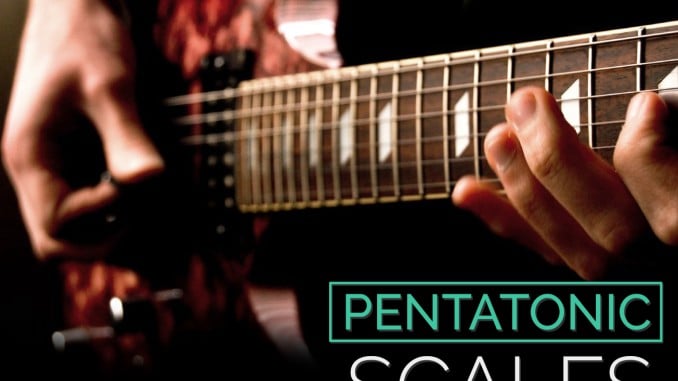
Learn the major and minor pentatonic scales, their patterns, when to use them, and why they’re the scale shortcut.
Pentatonic Scale Name
Pentatonic scales contain five notes, which is how it gets its name (Penta=5, tonic = tones). There is a major pentatonic scale and a minor pentatonic scale. The awesome part is that they contain the same note intervals (with differing roots), so the patterns are the same. You just need to learn a new root note.
Pentatonic Scales Are the Scale Shortcut
There are a few reasons that the penatonic scales are the short cut for the scales.
- You can learn the same exact patterns for both. You just need to know how the root note changes in the pattern.
- You can play the major pentatonic scale over almost any major or dominant chord without clashing with the chord.
- You can play the minor pentatonic scale over almost any minor chord without clashing with the chord.
- Sometimes you can play both scales over the same chord, especially for a bluesy sound.
Isn’t that an exciting and simple formula for success? This is why pentatonic scales are so popular.
Did you know the blues scale is based off the minor pentatonic scale. It just adds one note. Learn more in my blues scale lesson.
Play Over Major Chords
Play the major pentatonic scale over major chords.
For example, over C Major you could play the C Major pentatonic scale.
Some people claim that you can play the C minor pentatonic scale for a bluesy sound. Yes, you can, but you should be mindful of the notes you are playing. The minor pentatonic scale has a minor 3rd (or b3) while the major chord as a major third. This note can clash, but you can bend the minor third up a half step to a major third, which is a common tactic by blues guitarists.
Playing Over Minor Chords
Use the minor pentatonic scale over minor chords.
For example, play A minor pentatonic over an A minor chord.
Playing Over Dominant Chords
You can use both major and minor pentatonic scales, but once again, be cautious of the minor third when playing the minor pentatonic scale.
For example, you can play C Major pentatonic or C minor pentatonic over a C7 chord.
Dominant chords have a major third and a minor seventh (b7). The minor pentatonic scale has a minor third, which may clash with the chord’s minor third. Once again, bending the minor third up to the major third is a nice bluesy sound. In this case, the minor pentatonic scale contains the minor seventh, so that note sounds great.
The Major pentatonic scale does not have any clashing notes.
Advanced Note
If you are a fan of Jimi Hendrix, you know that he likes to play a Dominant7#9 chord. The 9 is also called the 2nd. The #9 is enharmonically the same as a minor third (b3). In other words, if you see this chord, it implies that you should play the minor pentatonic scale since it has a minor third.
Playing in a Key
I am cautiously going to make a recommendation here. Since the chords change, you can follow my rules below and be safe. All the notes should sound fine. Just remember that some notes will sound better than others depending on current chord.
In a major key, play the major pentatonic scale and its relative minor interchangably. In the key of C, you would play the C Major pentatonic scale or the A minor pentatonic scale.
In a minor key, play the minor pentatonic scale.
How to Form the Scale
I just told you that you can use the same patterns, but the difference is where they start. For example, if you use the C Major Pentatonic Scale, the matching minor pentatonic scale is the A minor pentatonic scale. It is 3 frets or semitones down from C. If you know your relative minor scales, A is the relative minor of C. Let’s take a look at two box patterns.
Example of a Pentatonic Box Pattern – the Same Notes
Take a look at these two popular pentatonic box patterns. You’ll note that they’re the same except the root note location is 3 frets down for the minor pentatonic scale. If you’re familiar with the CAGED chords, you’ll notice that this box pattern relates to the G form and the E form respectively. I will show you the box patterns for all the CAGED forms later.


What this means is that you need to know exactly five box patterns for both scales. I will cover patterns in greater depth below.
Forming Pentatonic Scales in Parallel
Another way to form the scale is in parallel, using the same root note rather than the relative minor. In my opinion, this is useful for learning the notes of the scale rather than just the pattern. To form the scales in parallel, you can take the major scale and use the formulas in the table below.
For example, the C major scale is C-D-E-F-G-A-B. To form the C Major pentatonic scale, you would take the 1 = C, 2 = D, 3 = E, 5 = G, 6 = A. To form the C minor pentatonic scale, you would take the 1 = C, b3 = Eb, 4 = F, 5 = G, b7 = Bb. You will notice that the notes are not the same because only the relative minor pentatonic scale has the same notes. In this case, it is A minor pentatonic which is A, C, D, E, G (the same notes as C Major Pentatonic).
| Scale |
Note Degrees (Based on the Major Scale) |
| Major Pentatonic | 1-2-3-5-6 |
| Minor Pentatonic | 1-b3-4-5-b7 |
Major Pentatonic Box Patterns
These are the five CAGED box patterns for the Major Pentatonic Scale. Can you pick out the major chords associated with the forms? You’ll notice that all the chord tones are there!
 G-form Box |

E-form Box |
 D-form Box |
 C-form Box |

A-form Box |
Minor Pentatonic Box Patterns
These are the five CAGED box patterns for the minor pentatonic scale. Notice that the root note location changes. Because the root note changes, you’ll also notice that the “chord form” changes too. The E minor box form is the same as the G Major box form. Some people avoid teaching CAGED for these boxes to avoid confusion. I think it’s best to associate the chord form, which you should know, to the proper box patterns.

E-form Box |

D-form Box |

C-form Box |

A-form Box |

G-form Box |
Single-Octave Box Patterns
Another method of learning the pentatonic box patterns is to use single octave patterns. If you know how to move single-octave box patterns around the fretboard, you can use these two patterns to simplify the learning process.
|
|
|
Diagonal Major Pentatonic Scale Patterns
The single-octave patterns can be linked to produce two diagonal patterns, each repeated three times. The figure below shows two diagonal major pentatonic patterns. The two combine to provide a pattern with a root on each string.


Diagonal Minor Pentatonic Scale Patterns
Similarly, the single-octave minor pentatonic pattern can be repeated to form two diagonal scales with roots on every string! Can you identify where these diagonal patterns fit the box patterns? As an exercise, I recommend finding where the box patterns fit into these diagonal scales.


Conclusion
Once you know the pentatonic scales, you are ready to play the blues. I highly recommend that you check out my 12 bar blues lesson to start improvising. You can also incorporate some blues licks. You can find some licks in my Licks, Riffs, and Tricks section.
If you liked this lesson, please let me know how I can improve it. If you want to learn more about chords, scales, and theory, check Guitar Lesson World The Book.







What do the filled-in and not-filled-in notes represent on the box patterns?
Thanks,
Blair
Blair, Thank you for your comment and question. Filled-in notes are root notes. Not-filled-in notes are the other notes of the scale. In a C major pentatonic scale, the C notes would be filled in. You can move the pattern around too. For example, if you went down in pitch by 1 fret, you would have the B major pentatonic scale. I hope this helps! If you need more information, you can find it in my lesson on chord diagrams, fretboard patterns, and rhythm charts.
Following on from your above explanation of the filled in dots being the root notes; if you look at several of the box samples e.g e form box pattern and g form box pattern
The first note of the e form box pattern (in the diagram) is being played on the first fret on the e string, but this is an f(e#). Also seventh note on the g form box is also being played on the first fret of the g string and is therefore a g#.
Are these box form diagrams therefore correct?
PaulS
Thank you for your question. The box patterns are moveable patterns and not showing a specific fretboard location, though I can see why you were confused. You must place the root note on the proper note rather than assuming the fret number of the box pattern. The root note can be on an open string. In the case of the E minor pentatonic box, the first fret of the pattern should be the open strings (or the 12th fret if you want to play an octave up). Similarly, the G major box pattern, should be rooted on the open 3rd string or 12th fret of the 3rd string. I hope this helps!
I just was trying the same lesson and had the same questions. Thanks for you clear, helpful explanation. Now I’m getting it!
enjoyed lessons with multiple approaches
Thank you.
This is a big help.
Good illustration.
What do the black dots represent?
Thank you for the question. The black dots are the root notes of the pattern.
Are rhe root notes played first and the note right before the next root note is that the completed scale or does the scale end on next root note.
If played sequentially, a scale technically does not include a root note at the end. In practice, many people include it. In my opinion, it is important that you know the sequence and how to find notes relative to the root note, such as which note is the 5th note of the scale. When practicing, I like to repeat the root note at the end because you can start a new scale from that note. It also provides a nice feeling of resolution.
I hope this helps!
This is very useful.
One thing I’m struggling with is the idea of flatted 3rd and 7th in the minor pentatonic scale. In the patterns above, if you take E form box, the notes are simply E G A B D. I don’t get the ‘flatted’ part?
In the key of E, you have the notes E F# G# A B C# D#. Minor pentatonic removes 2 and 6 leaving E G# A B D#. Making it minor flattens the 3rd (G#) and 7th (D#) making the notes E G A B D. I hope this helps!
Great article, here’s how I found it. I printed off both the major and minor patterns from a paid tuition site I joined, the opposite of “falseice” and noticed that pattern 5 of major looked like pattern 1 of minor and the other matched too! Had to google it to make sure I wasn’t nuts.
I’m glad you liked the article!
Awesome work! I love the diagonal patterns.
Thank you for the kind words! A lot of people enjoy the diagonal patterns for improvisation once they learn them!
Thank you for showing the diagonal patterns. This is the only site that does this. I taught myself the diagonal patterns but always wondered what I was doing wrong (or right). I think the diagonal patterns should be the standard way these scales are illustrated. But maybe I AM doing something wrong.
I’m glad you use them, and thank you for the kind words! One of my goals is to unlock the guitar tricks that make it easier to play. I think it is harder to apply diagonal patterns to written music in the same way traditional instructors teach position playing. However, if you are soloing or improvising, I think they are essential. Thanks for the kind words!
I think of scales as a series of steps (moving up or down two frets) slides (sliding up or down two frets) and skips (jumping from one string to the other). The minor pentatonic would be root-skip-step-slide-skip-step. The major pentatonic would be root-step-step-skip-step-skip. You can throw in hammer-ons and pull-offs and blue notes as desired. Actually, when I’m playing never think about scales at all, I just play.
Sorry for the delayed reply. I never thought of them in this way. I’m glad you shared this thought. Musicians often come up with ways to play effortlessly. It takes practice, but there is a mental approach to everyone’s playing. Your comment expresses this in a way that may help others. Thank you!
I’ve been playing with the diagonal patterns since they seem be be easier to memorize. I’ve been calling the method “waterfall”. How far can I go with this technique and what do I lose by not memorizing the CAGED boxes?
Thank you for the question! There are benefits to both. I like the diagonal patterns because they help you move up and down the fretboard. CAGED lets you play in a single position and attach it to the various chords in the progression. This can be very useful. This chord mapping can be done with diagonals too. With all these techniques, these mental models are intended to make learning easier so we can play without thinking too much. If diagonals work for you, enjoy it!
Hi,
I am exploring the use of the major and minor pentatonic scales. I know all the shapes. I have read lots on the subject and I have also watched a lot of videos. Unfortunately, I’m still confused about something.
Why would would you use minor pentatonic scales in a three chord blues song with three major chords?
Thank you for posting your question! Blues songs can break some “rules” to create “tension and release”. Many blues songs use dominant chords for the I, IV, and V chords, which all have a major third in them. If they’re 7th chords, this means that they occasionally play a b7 and a b3 in the key. The minor pentatonic scale has a b3 and a b7 to highlight this distinction. Also, you can bend the flat note up a half step to put it “in key”.
This is a great tool! CAGED is a real eyeopener! I’ve been “playing” for ever but only recently gotten serious about actually PLAYING instead of noodling.So thank you.
Are there other examples of diagonal patterns or do the above ones work for any key?
Thanks again! You rock!
Thanks for the kind words.
There aren’t many diagonal patterns because they cover so much distance up and down the fretboard. Some guitarists play more than two or three notes per string, which can extend the pattern farther down the fretboard. To play different keys, just move the root notes based on the key.
Linking single-octave scales can be done with other scales too. Similarly, the CAGED relationship is valid for major scales and minor scales too.
This is the most succinct and clear explanation of the pentatonic patterns I’ve come across – really good writing. Thank-you
Hi Patrick….I know that the Major pentatonic pattern takes out the 7th and 4(11) note in the scale.
However, can you still play a b7 or a #4? or are all 7th and 4th notes out?
Likewise, in the minor pentatonic scale which takes out the 2nd(9) and 6 (13)….can you play a #5(b6)?
Hi Robert,
Thanks for the question. Let me start by noting that pentatonic scales remove half steps from the scale, which removes the dissonant notes. Therefore you will sound consonant unless you add notes or a chord plays a note outside the pentatonic scale you’re playing.
If you are playing a Major Pentatonic Scale over a dominant 7 chord, adding the b7 makes a lot of sense because it is a chord tone of the dominant 7 chord. Example: You could add Bb over a C7 chord when playing C Major Pentatonic.
The 4th is generally omitted because it is a half step from the major 3rd, which is in every major and dominant chord. Playing it will clash with those types of chords. However if you want dissonance, go for it.
The #4 will clash with the 5th which is also in every chord major or minor unless purposely omitted. If you want dissonance, go for it. If you want consonance, perhaps play it when a chord voicing omits the 5th. This of course assumes your scale and chord have the same root note.
Adding an augmented 5th, or #5, also clashes with the 5th, which can be omitted.
For some styles, like the blues, the 2nd/9th and 6th/13th are often added, but it really depends on the harmonic context (the chords) and whether you want consonance or dissonance.
I hope this helps!
TY Pat, yes after doing some investigation I noticed that if you add b or # notes to the Pent scale you most likely will end up with some exotic scale (Kumol, Spanish Gypsy, Algerian, etc or even some Blues scales); these may sound good….or maybe not…so I guess you just have to experiment. I am a bass player and to be honest….I make up my bass lines in my head as to how I hear them. However , if I don’t have the time to make up a bass line (ie.. improvise on the fly), I rely on pentatonics to give me a sure bet as to what will sound good. I don’t rely on “Church Modes” to construct my lines which is probably against what most teachers will instruct students in first. The Pents are much simpler and they take out the possible “bad sounding” notes. As mentioned before, you can always put them(#,b’s or even 4(11),7 / 2(9),6(13) in to experiment, or of course if the chord calls for it. Thank you again for your help.
Thank you for your comment.
I am certainly a fan of starting with Pentatonic scales and adding notes. One example is the blues scale, which takes the minor pentatonic scale and adds the b5, also known as the #4 or tritone. If you read about the original blues musicians, they didn’t learn the blues scale first. The blues scale was more of a teaching device for those who wanted to emulate the blues. Even that is limited because blues musicians often bend the b3 up to a natural 3rd (due to the prevalence of dominant 7 harmonies). This gives the sense of mixing minor and major pentatonics plus adding the tritone.
I believe playing basslines is a great way to learn scales, which has many benefits for rhythm and lead guitar.
One tip I can give that you may already know is that if you are in a key (let’s say A) and the progression is a I-IV-V with diatonic chords (Amaj7-Dmaj7-E7). These are chords formed off the notes in the key’s major scale. You can play the chord tones off the major scale by starting on the root of the chord and playing every other note of the key’s major scale (A major scale). It’s a one-scale approach, but it is a sneaky entrance into using modes. It is limited, however, because many progressions do not follow strict diatonic scales.
One thing you might add—though this could clutter up the charts— is the interval numbers. I find it helpful to say the interval when I practice the scales. If I have an A note, then I can quickly form the minor or the major chord if I know where to find the flat3 or 3 and 5.
This is a good suggestion. I’ve debated having interval-based boxes. There is always a balance of how much to read from the chart and recall. I will consider your suggestion. Thanks!